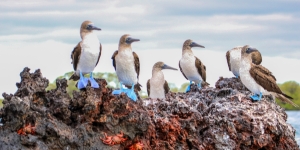The habitats of the neotropics are diverse, though, and there’s much to discover by mixing things up. Climb higher in elevation and you may find the cloud forest, where cooler temperatures and persistent, low-lying clouds create a verdant and ethereal atmosphere, rich with mosses and bromeliads. These forests host an incredible diversity of birds, many of which are distinct from their lower-elevation counterparts.
A visit to the cloud forest is a must on any tropical journey. If you need convincing, here are nine cloud forest species that are easily worth the trek:
Resplendent Quetzal
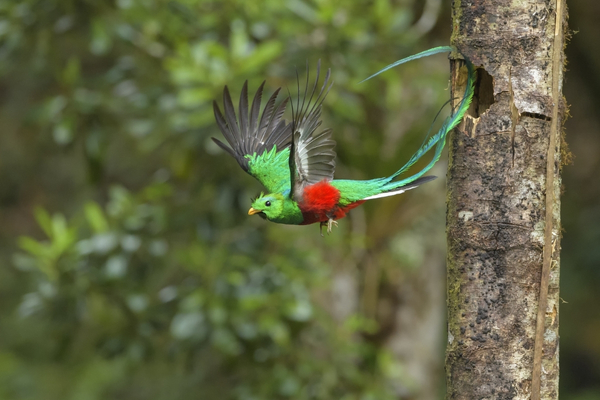
There may be no bird in the world more emblematic of a particular habitat than the Resplendent Quetzal. It so strongly associated with Central American cloud forests that it appears on nearly every lodge, storefront, and road sign in the region. It has become the de facto face for Costa Rican ecotourism, and is the national bird of Guatemala.
The quetzal’s notoriety is well-deserved, as it is a dedicated resident of the cloud forest and about as spectacular as a bird can be. The male is clad in glittering green with a scarlet belly, and carries a quartet of gaudy streamers above its tail. The female samples the male’s extravagant colour palette, but sets it against soft grey for a more subdued elegance.
The Resplendent Quetzal ranges from the threatened cloud forests of southern Mexico to the western end of Panama, and it is sought after by visiting birders wherever it lives. It is a quiet bird of the canopy, and its spectacular colours blend surprisingly well with the leaves in which it rests. It has an affinity for wild avocado trees, so finding the fruit is often the key to finding the bird.
Three-wattled Bellbird
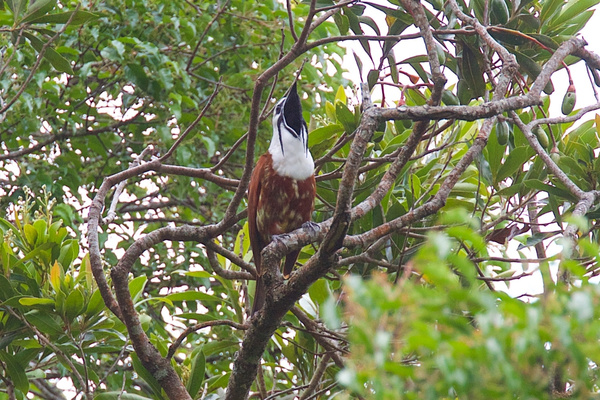
Less well-known but no less incredible than the quetzal, the Three-wattled Bellbird breeds in cloud forests from Honduras to Panama. The bellbird is a treat for the ears as well as the eyes, as its short but powerful song is among the loudest in the world.
The bellbird looks like two different birds stitched together, as its rich, rufous body contrasts sharply with a stark white head. Its most striking feature, though, is three fleshy, black wattles that hang down from the base of its beak – an adornment unlike any other in the bird world. The female looks like a different species altogether, with rich, olive plumage smartly streaked in yellow.
The Three-wattled Bellbird is an altitudinal migrant, moving to lower elevations during the nonbreeding season and returning to the cloud forest to breed. Like the quetzal it is a fruit-eater, and its annual journey allows it to follow the richest crops. Since its location changes through the year, timing and a little research is important if you want a shot at seeing one.
Violet Sabrewing
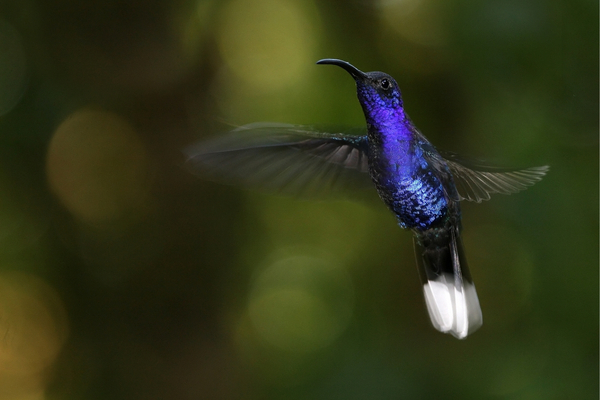
Hummingbirds abound in the cloud forest, but the Violet Sabrewing may be the boldest and brashest of them all. This purple monster is the largest hummer in Central America, and it has an attitude to match its proportion.
The shimmering, iridescent garb of the Violet Sabrewing appears black in the shade, so this seemingly brilliant bird disappears on its perch under the forest canopy. Its piercing calls may give it away at a standstill, and its brilliant white tail corners betray it as it zooms from flower to flower. At nectar feeders it is an absolute menace, harrying and chasing all other hummingbirds who dare feed at its chosen station.
The sabrewing inhabits cloud forests from Mexico to Panama, and is an unmissable and unforgettable visitor to hummingbird feeders throughout its range. If you like your hummers big and bold, this is the bird for you.
Black Guan
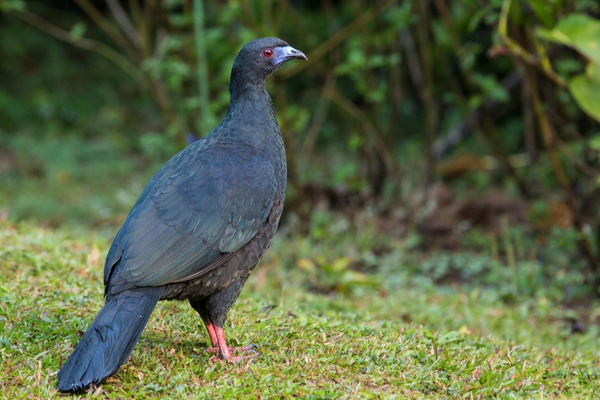
If you are walking along a cloud forest trail in Costa Rica or western Panama, you may be alarmed to hear the sudden crashing of a large animal in the branches overhead. You’ll imagine it might be monkeys, as you peer into the dense foliage. You might even find yourself, somewhere deep in the back of your mind, considering the possibility that it’s something bigger and more threatening.
As you retreat a safe distance down the trail and find a different sightline into the bramble, you may be surprised to see a little, blue, beaked face poke out from between the leaves: a face that belongs to a Black Guan. This large, chicken-like bird is a surprisingly arboreal resident of these forests, and is far from stealthy as it clumsily ambles between the branches in search of tasty fruit.
The guan is certainly handsome, if you can find a clear view. Its jet-black plumage draws immediate attention to its bare, indigo facial skin and piercing red eyes. A pair of smart, red socks completes the look. You’ll be glad you persevered through the terror.
Black-faced Solitaire
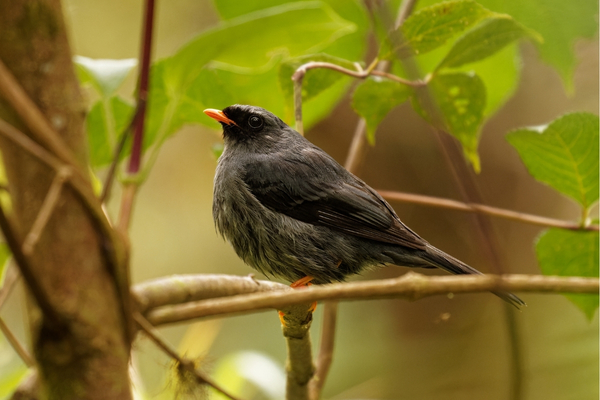
Though it is far more often heard than seen, the solitaire is a handsome bird. Males and females look alike, with soft, slaty grey plumage accented by a black face and wings. A brilliant yellow-orange beak and feet provide a welcome pop of colour against the cloudy backdrop.
The Black-faced Solitaire is a lover of dense undergrowth, so spotting one can be a challenge even when your ears lead you in the right direction. It shares its habits and vocal quality with cousins to both the north and south, so solitaires are a prominent and evocative feature of the cloud forest soundtrack throughout the neotropics.
Andean Cock-of-the-Rock
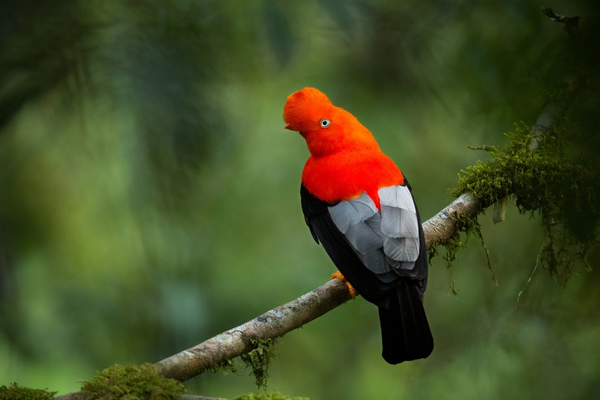
An improbable bird with an improbable name, the Andean Cock-of-the-Rock is a celebrated resident of the cloud forests of the Andes. Much as the quetzal dominates the ecotourism landscape of Central America, the cock-of-the-rock is on every sign and poster in the cloud forest regions of South America.
The male Andean Cock-of-the-Rock could not be more ridiculous, with creamsicle-orange plumage set against a black and wings with grey accents. An erect crest forms a sort of pompadour hairdo which completely obscures the beak, giving the impression more of a bizarre muppet than a living bird.
If you were worried that this absurd outfit doesn’t come with a goofy dance, worry no more. Male cocks-of-the-rock gather in groups called leks where they puff up, flap, hop, bob, and squawk their hearts out. The tastefully dressed female simply visits the lek like a shopper at a car dealership, selecting the model with the best bells and whistles from the available stock.
Andean Cock-of-the-Rock leks are one of the great spectacles of neotropical birding, and their predictable locations tend to provide easy viewing opportunities. They are an absolute must-see for anyone birding the Andes from Colombia to Bolivia.
Plate-billed Mountain-Toucan
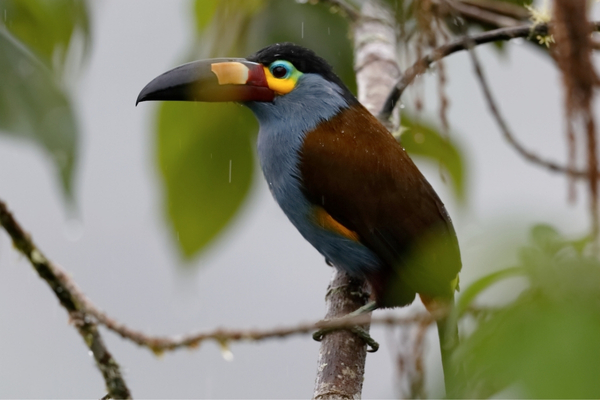
Toucans may call to mind the hot and humid tropical lowlands, but the cloud forest has its share, too. Many of these higher-elevation species differ from their large, bright, rainbow-beaked counterparts, often being smaller in size and somewhat more subdued in their colour palette. Some might even say they are more attractive, and the Plate-billed Mountain-Toucan is the perfect case in point.
Forget the gaudy ‘Toucan Sam’ aesthetic of the Toco or Keel-billed. The Plate-billed Mountain-Toucan wears a sophisticated mix of cool grey and rich olive. A bright red undertail and yellow flash on the flank provide welcome pops of colour, and bare skin around the eye is painted with lemon yellow and sky blue. The serrated bill complements black with rich mahogany, and sports the unusual ivory-coloured plate that gives the species name.
The plate-billed is truly intoxicating to look at. It lives only in a narrow band of forest shared between Ecuador and southern Colombia, so seekers of this unique beauty must plan accordingly. Though often concealed in the canopy, it will visit fruit-feeders, providing excellent viewing of what may just be the best-looking toucan in the world.
Club-winged Manakin
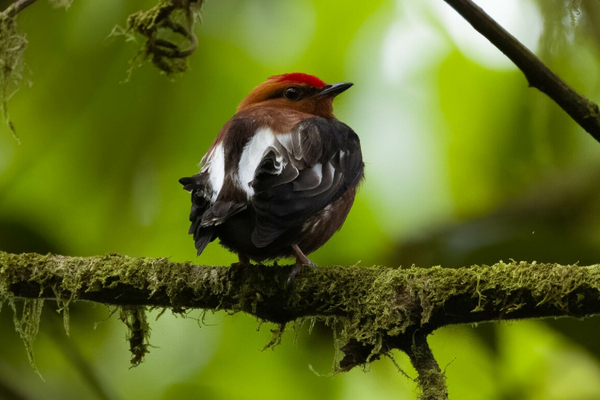
Many male manakins perform elaborate courtship dances, often gathered together in leks similar to those of the cock-of-the-rock. Their bright colours are on full display as they flap, dip, bob, bow, and zip across their chosen arena. One species, the Red-capped Manakin, even performs a moonwalk that would put Michael Jackson to shame.
Up in the cloud forest, the Club-winged Manakin lacks the moves of many of its cousins. Instead, it impresses would-be mates by leaning forward, raising its wings over its back, and vibrating a few special feathers against each other to produce a single, clear, musical note. White flashes on the wings add a visual element to this incredible party trick.
The sound made by the Club-winged Manakin is unlike that of any other bird. Mechanically it has more in common with the chirps made by crickets and cicadas. It is a unique and striking feature of the soundscape of a small band of cloud forest in Colombia and Ecuador, and well worth the journey to that part of the world.
Scaled Fruiteater
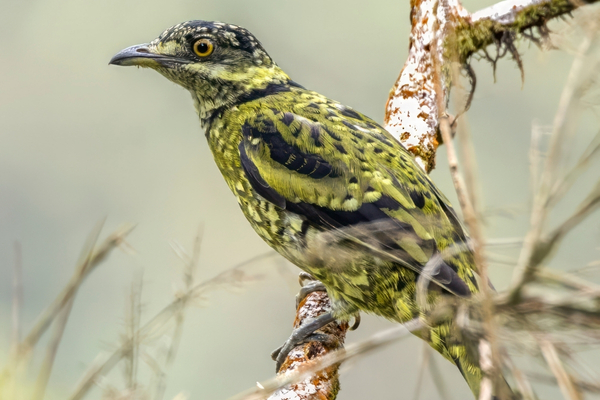
The cotinga family is well represented when it comes to spectacular birds of the cloud forest. This varied group of unusual birds gives us both the bellbird and cock-of-the-rock mentioned earlier in this list. It is also home to the fruiteaters.
All of the world’s dozen or so fruiteaters are stunning, but even in this rich company, Scaled Fruiteater stands out. It appears as though a tidy black and white bird stood still too long on the cloud forest’s mossy blanket, and the moss has simply grown over it in a perfect, reticulated pattern. It is at once a part of the forest it inhabits, and strikingly singular.
The Scaled Fruiteater ranges from Venezuela to Bolivia. Like all birds on this list, it would be easily missed on your tropical birding journey without a dedicated visit to its unique and important habitat. Birding the lowland rainforests of the neotropics is an incredible experience, but when you need a break from the sweltering heat, the cloud forest is waiting. It will be worth the trek. I guarantee it.
You can spot some of these species and more on our upcoming tours:
Classic Costa Rica: Quest for the Quetzal | January 23 – February 2, 2026 | Click here
Ecuador's Highlands tour with Ontario Nature | February 22 – March 5, 2026 | Click here
Panama Wildlife Retreat | March 1 – 9, 2026 | Click here
Colombia's Santa Marta and Caribbean | March 13 – 23, 2026 | Click here


